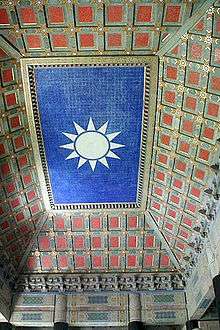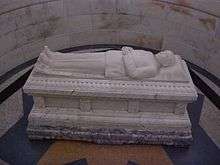Sun Yat-sen Mausoleum
| Sun Yat-sen Mausoleum | |||||||||||||||
|
The main hall of the Sun Yat-sen Mausoleum. | |||||||||||||||
| Chinese | 中山陵 | ||||||||||||||
|---|---|---|---|---|---|---|---|---|---|---|---|---|---|---|---|
| |||||||||||||||

Dr. Sun Yat-sen's Mausoleum (Chinese: 中山陵; pinyin: Zhōng shān líng) is situated at the foot of the second peak of Mount Zijin (Purple Mountain) in Nanjing, China. Construction of the tomb started in January 1926, and was finished in spring of 1929. The architect was Lu Yanzhi, who died shortly after it was finished.
History
Dr. Sun was born in Guangdong province of China on 12 November 1866, and died in 1925 in Beijing, China. On 23 April 1929, the Chinese government appointed He Yingqin to be in charge of laying Dr. Sun to rest. On 26 May, the coffin departed from Beijing, and on 28 May, it arrived in Nanjing. On 1 June, 1929, Dr. Sun was buried there. Sun, considered to be the "Father of Modern China" both in mainland China and in Taiwan, fought against the imperial Qing government and after the 1911 revolution ended the monarchy, and founded the Republic of China.
- Sun Yat-sen Mausoleum
 Sun Yat-sen Mausoleum in Nanjing
Sun Yat-sen Mausoleum in Nanjing 1 May 2011 (Labour day)
1 May 2011 (Labour day) 1 May 2011
1 May 2011 The Entrance Gate
The Entrance Gate Gate
Gate Marble sarcophagus
Marble sarcophagus Sun Yat-sen Sacrificial Hall information
Sun Yat-sen Sacrificial Hall information
Selection of the design
A committee decided to host a design competition in order to collect designs for the Sun Yat-sen Mausoleum. The committee put advertisements in the newspapers on 5 May, 1925, inviting architects and designers at home and abroad to send their designs. In exchange for a 10 yuan charge, the committee would provide the designer with 12 pictures of the site.
The design would have to adhere to guidelines. It had to be done in a traditional Chinese style that also evoked a modern design with special and memorial substance. Not only should it evoke the Chinese architectural spirit, but also add creativity. Designers were required to insure that the proposed construction costs within 300,000 yuan (the final cost exceeded 3,000,000 Yuan). Over 40 proposals were received.
On 20 September, 1925, the committee convened in Shanghai, and unanimously selected Lu Yanzhi's proposal.
Architecture

Reclining on a mountain slope, the majestic mausoleum blends the styles of traditional imperial tombs and modern architecture. Lying at the mountainside, the vault is more than 700 meters away from the paifang on the square below, which is the entrance of the mausoleum. There is a three-tier stone stand on which a huge bronze ding, an ancient Chinese vessel symbolizing power, perches. To the north of the square, the paifang towers high. Beyond is the 480-meter-long and 50-meter-wide stairway which has 392 stairs leading to the vault. On both sides, pine, cypress, and ginkgo trees guard the way. At the end of the stairway is a gate which is 16 meters high and 27 meters wide. The tri-arched marble gate is inscribed with four Chinese characters written by Dr. Sun, "Tian Xia Wei Gong" ("天下为公") which means "What is under heaven is for all". Inside the gate, there is a pavilion in which a 9-meter-high stele is set, which is a memorial monument set by the Kuomintang (KMT). A few stairs up is the sacrificial hall and the vault.
In front of the sacrificial hall there stands a pair of huabiao, ancient Chinese ornamental columns, which are 12.6 meters high. The sacrificial hall is actually a palace of 30 meters in length, 25 meters in width and 29 meters in height. In the center of the hall a 4.6-meter-high statue of Dr. Sun sits. The statue was sculptured out of Italian white marble. The hall's ceiling features the flag of the Kuomintang. Biographical information on Dr. Sun is available to visitors in the hall. North of the hall lies the bell-shaped vault, wherein lies the sarcophagus of Dr. Sun.
Architectural influence of the Mausoleum's design is evident in Taiwan's Chiang Kai-shek Memorial Hall.
High profile visits
On 27 April 2005, Kuomintang (KMT) Chairman Lien Chan, his wife, and other KMT members visited the Mausoleum. It was the first visit of KMT members to the site since 1949.
On 15 November 2006, a visit was made to the Mausoleum by Dr. Sun's granddaughter, Sun Huiying, who was by then over eighty years old.
In May, 2008, Wu Po-hsiung became the first ruling KMT Chairman to visit the Sun Yat-sen Mausoleum since 1949. There were concerns that the 392 steps leading to the tomb would be too taxing given Wu's leg injuries.
On 12 February 2014, Wang Yu-chi became the first ROC government official in office to visit the site after the end of Chinese Civil War in 1949.[1]
On 31 October 2016, KMT Chairperson Hung Hsiu-chu visited the mausoleum during her mainland trip for the Cross-strait Peace Development Forum.[2]
See also
- National Chiang Kai-shek Memorial Hall
- Cihu Mausoleum
- Touliao Mausoleum
- Sun Yat Sen Nanyang Memorial Hall
- Sun Yat-sen Memorial Hall
- Sun Yat Sen Memorial House
- Sun Yat-sen Museum Penang
References
External links
| Wikimedia Commons has media related to Sun Yat-sen Mausoleum. |
Coordinates: 32°3′51.90″N 118°50′53.77″E / 32.0644167°N 118.8482694°E
